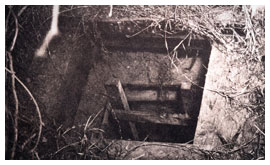Great Papago Escape

The entrance to the tunnel was concealed by a large box of coal.
|
|
| Date | December 23, 1944 – January 28, 1945 |
|---|---|
| Location | Camp Papago Park, Arizona, United States |
| Participants |
Jürgen Wattenberg Hans-Werner Kraus Friedrich Guggenberger August Maus |
The Great Papago Escape was the largest Axis prisoner-of-war escape to occur from an American facility during World War II. On the night of December 23, 1944, twenty-five Germans tunneled out of Camp Papago Park, near Phoenix, Arizona, and fled into the surrounding desert. All of the escapees were eventually recaptured without bloodshed over the next few weeks, and although most were detained within Maricopa County, a few nearly made it to the border of Mexico, which is about 130 miles south of the camp.
Camp Papago Park was built in 1943 and located in Papago Park, a public recreational area in eastern Phoenix. Initially, the camp was to be used for Italian prisoners, but by January 1944 it had been designated for use by the Germans only, most of whom were from the Kriegsmarine. The camp consisted of five separate compounds; one for officers and the rest for enlisted men. At its peak, the population of the camp was about 3,100, excluding the 371 American guards and officers. Camp Papago Park was a typical prison camp in terms of appearance, surrounded by barbed wire and watch towers, but it was unusual in that prisoners were not required to work or study. However, to combat boredom, many of the Germans volunteered to work in the nearby cotton fields and the like.
Many of the men in the officer's compound were U-boat sailors, including the commander, Captain Jürgen Wattenberg, who was the highest ranking German prisoner at the camp. He was a veteran of the Battle of the River Plate, as well as the commander of U-162, which was sunk off the Bahamas by the Royal Navy in September 1942. Because by this time the United States and Germany were at war, the British transferred Wattenberg and his crew into American custody. According to author Cecil Owen, "Wattenberg was shuffled from one camp to another, for nobody wanted to keep him. He was considered a 'Super Nazi' because he caused trouble everywhere he was sent. Finally he was transferred to Papago Park prisoner of war camp, in the Arizona desert." Wattenberg was not alone though: The American commander of the camp made the mistake of putting all of the most troublesome and escape-prone inmates in the officer's compound together, instead of dispersing them. The camp's provost marshal, Captain Cecil Parshall, was the only one to see a problem with this arrangement. Parshall pointed out that there was a spot in the officer's compound that could not be seen from the guard towers, making an ideal location for an escape. He also said that the "German [prisoners] were a fine bunch of men, smart as hell, [a]nd it made no sense to put the smartest of them in Compound 1 [officer's compound]. I knew they would discover that blind spot."
...
Wikipedia
